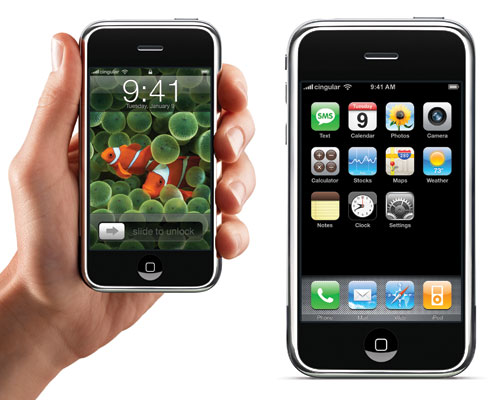Hosted by site sponsor WebMate.
iPhone Q&A
Revision Published June 14, 2008
All Apple Q&As >> iPhone Q&A (Home)
To be notified of new Q&As, sign up for EveryMac.com's bimonthly email list.
What exactly is the original iPhone?
Please note that this Q&A specifically refers to the original iPhone. It can be quite useful for historical reference as well as general information.
For detailed comparisons between subsequently introduced iPhone models, see EveryiPhone.com's main iPhone Q&A page.
After years of speculation, Apple has delivered a handheld with phone, iPod, and and Internet functionality. Apple marketed the iPhone by summarizing the product as:
A revolutionary mobile phone, a widescreen iPod with touch controls, and a breakthrough Internet communications device with desktop-class email, web browsing, maps, and searching -- into one small and lightweight handheld device.

Photo Credit: Apple, Inc.
Self-describing any product as "revolutionary" is gutsy, if not arrogant, but the iPhone offers an impressive patented "multi-touch" interface that allows one to control the device by sliding one or more fingers across the touch sensitive display.
Effectively, the iPhone screen acts as a far more advanced version of the "Scrolling Trackpad" first introduced on January 31, 2005 in the PowerBook G4 series. The iPhone also has an accelerometer -- most likely based on the "Sudden Motion Sensor" technology likewise introduced with the PowerBook G4 -- that allows the iPhone to "know" whether it is being held in portrait or landscape mode and automatically switch accordingly. For example, one might choose to use the device in portrait mode for phone calls and landscape mode for web browsing.
In addition to the "self switching" accelerometer, the iPhone has an ambient light sensor -- first introduced with the PowerBook G4 1.0/17" (Al) -- to automatically adjust screen brightness depending on need, and a slick "proximity sensor" to turn off the display when it is held to the ear (otherwise you might accidentally operate it with your face).
The iPhone measures 4.5 inches by 2.4 inches, is 0.46 of an inch thick (115 by 61 by 11.6 mm), and weighs a scant 4.8 ounces (135 grams). It features a high-resolution "optical quality" glass 3.5 inch display with 320x480 resolution at 160 ppi. It has 4, 8, or 16 GB of flash memory storage, provides "up to" 8 hours of talk time, 24 hours of audio playback, 7 hours of video playback, 6 hours of web browsing, and 250 hours of standby time. It also has a 2.0 megapixel digital camera.
Apple says that the iPhone has just one button -- Home. However, it also has volume up/down, ringer on/off, and sleep/wake buttons.
iPod
The "iPod" functionality of the iPhone is about what you would expect. Just like the "full-size" iPod 5G models, the iPhone allows one to listen to music and audiobooks and watch videos, television shows, and movies. However the iPhone also offers "Cover Flow" navigation to browse albums by cover art in addition to a list view. The iPhone has a USB-based iPod "dock connector" port on the bottom and all content can be synchronized to the iPhone using iTunes.
Phone
The phone functionality of the iPhone makes it possible to make calls by touching a name in your address book or call log, and send text messages using a "virtual" on screen keyboard. It also has "Visual Voicemail" so voicemails can be selected in any order by touch and provides a photo management application. Contacts can be synchronized from "a PC, Mac, or Internet service".
It is a "Quad-band" phone (850, 900, 1800, 1900 MHz) and officially restricted to the Cingular/AT&T Wireless network in the United States and specific carriers in other markets as well.
Internet
The iPhone supports Wi-Fi (802.11b/g), and Bluetooth 2.0 (as well as EDGE). It includes a version of the Safari web browser that makes it possible to view standard webpages -- and clicking and "pinching" to zoom in on content to read -- rather than being forced to use websites specifically designed for a mobile display or scrolling horizontally. It also has an HTML e-mail client, built-in Google and Yahoo! search, integrated Google Maps, and a number of bundled Dashboard widgets.
Perhaps most impressive, the iPhone is "fully multi-tasking" so e-mail can be downloaded while browsing the web, and you can even switch between applications while using the phone functionality.
Conclusion
In some ways, the iPhone is at least as much a handheld computer as a phone, but it is not based on the long ago discontinued -- but well ahead of its time -- Newton MessagePad.
Also see:
- What operating system does the iPhone use? Can it run MacOS X applications like Skype and Photoshop?
- What applications are available for the iPhone? Will third-party applications be available in the future?
- How long is AT&T Wireless the exclusive iPhone carrier in the US?
- What are the "pros and cons" of the original iPhone? Is it right for my needs?
- What are all the differences between the original iPhone and the iPhone 3G?
Permalink | Report an Error/Typo | Sign Up for Site Update Notices
<< iPhone Q&A (Main) | All Apple Q&As
Established in 1996, EveryMac.com has been created by experts with decades of experience with Apple hardware. EveryMac.com includes, and always has included, original research incorporating detailed, hands-on inspection of packaging, computers, and devices as well as extensive real-world use. All information is provided in good faith, but no website or person is perfect. Accordingly, EveryMac.com is provided "as is" without warranty of any kind whatsoever. EveryMac.com, and the authors thereof, shall not be held responsible or liable, under any circumstances, for any damages resulting from the use or inability to use the information within. For complete disclaimer and copyright information please read and understand the Terms of Use and the Privacy Policy before using EveryMac.com. Copying, scraping, or use of any content without expressed permission is not allowed, although links to any page are welcomed and appreciated.
